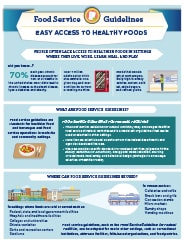Food Service Guidelines: Easy Access To Healthy Foods
People often lack access to healthier foods in settings where they live, work, learn, heal, and play.
Did you know. . .?
- Each year, chronic diseases account for 70% of all deaths in the United States. Poor diets lead to chronic illnesses, such as heart disease, type 2 diabetes, and obesity.
- Over 7 million adults eat or drink at a cafeteria on a given day, and over 9 million do so from a vending machine.
- Foods that people get at work are generally high in empty calories, sodium, solid fat, added sugars, and refined grains.
On This Page
- What Are Food Service Guidelines?
- Food Service Guidelines for Federal Facilities
- Where Can Food Service Guidelines Be Used?
- What Are the Potential Benefits of Food Service Guidelines?
- How Does CDC Help Ensure Healthy Food Offerings?
- How Are States and Communities Improving Availability of Healthier Foods in Food Service?
Food Service Guidelines for Federal Facilities
- The Food Service Guidelines for Federal Facilities (FSG) encourages healthier food service at federal worksites and is a model set of guidelines that can be used or adapted in other settings.
- More than 60 scientists and operators from nine federal departments and agencies developed the FSG.
- The FSG provides specific standards for food and nutrition (aligned with the Dietary Guidelines for Americans), energy and waste reduction, sourcing of local foods, food safety, and behavioral design (strategies to encourage selection of healthier foods).
In settings where foods are sold or served such as:
- Federal, state and local government facilities.
- Hospitals and healthcare facilities.
- Colleges and universities.
- Private worksites.
- Parks and recreation centers.
- Stadiums.
In venues such as:
- Cafeterias and cafés.
- Snack bars and grills.
- Concession stands.
- Micro markets.
- Sundry shops.
- Vending machines.
Food service guidelines, such as the Food Service Guidelines for Federal Facilities, can be adapted for use in other settings, such as correctional institutions, eldercare facilities, faith-based organizations, and food pantries.
How Does CDC Help Ensure Healthy Food Offerings?

CDC . . .
- Funds states and communities to use food service guidelines in various settings.
- Invests in trainings and action institutes to support food service guidelines efforts.
- Develops tools and resources.
- Monitors progress of food service guidelines implementation in states and communities.
- Connects stakeholders with research activities.
How Are States and Communities Improving Availability of Healthier Foods in Food Service?
- Washington reported increases in healthier food and beverage offerings in various venues after the governor signed an executive order that required all state facilities to adopt healthy food guidelines.
- Los Angeles County requires nutrition standards in food contracts across county departments. This policy is estimated to impact 37 million meals per year.
- Missouri applied nutritional guidelines to food service in their state and local parks and saw increased profits.
- Kentucky saw a substantial growth in sales after adding healthier options and labeling in state-operated cafeterias.
Error processing SSI file
Page last reviewed: October 20, 2021


